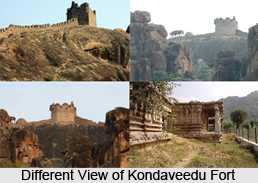 Kondaveedu Fort, also known as Kondavid Fort, is an ancient hill fort situated in Kondaveedu village in the district of Guntur, Andhra Pradesh. The fortress is district atop a hill at a height of 520 m. Apart from the Kondaveedu Fort there are 2 other minor forts in the area. The geographical coordinates are latitude 16.2597øN and longitude 80.2653øE. It was mainly constructed with granite stones and lime mortar. The structure was built by Prolaya Vema Reddy of the Reddy Dynasty during the 13th century. The Reddy dynasty occupied the fort from 1328 to 1428. Later it was captured by the Gajpathis of Orissa. In 1458, the fort was damaged by the Muslim rulers of the Bahmani Sultanate. Krishnadevaraya of the Vijayanagar Empire took over the fort in 1516 and it was later ruled by Sultan Quli Qutb Shah in 1579. The region was then renamed as Murtuzanagar.
Kondaveedu Fort, also known as Kondavid Fort, is an ancient hill fort situated in Kondaveedu village in the district of Guntur, Andhra Pradesh. The fortress is district atop a hill at a height of 520 m. Apart from the Kondaveedu Fort there are 2 other minor forts in the area. The geographical coordinates are latitude 16.2597øN and longitude 80.2653øE. It was mainly constructed with granite stones and lime mortar. The structure was built by Prolaya Vema Reddy of the Reddy Dynasty during the 13th century. The Reddy dynasty occupied the fort from 1328 to 1428. Later it was captured by the Gajpathis of Orissa. In 1458, the fort was damaged by the Muslim rulers of the Bahmani Sultanate. Krishnadevaraya of the Vijayanagar Empire took over the fort in 1516 and it was later ruled by Sultan Quli Qutb Shah in 1579. The region was then renamed as Murtuzanagar.
After the French East India Company captured the structure in 1752, it was renovated and strongly fortified. In the year 1788, Kondaveedu Fort was occupied by the British East India Company. However it was abandoned during the early 19th century. Presently the fortress is maintained by the Government of Andhra Pradesh.
History of Kondaveedu Fort
The Kondaveedu Fort or Kondavid Fort and the other two fortresses in the vicinity were founded by Prolaya Vema Reddy in the 13th century. The fort and the territory were occupied by several rulers from different dynasties. All the separate rulers followed different strategies in administering the fort and the province. The territory flourished and prospered during the reign of Hindu rulers; whereas during the rule of the Muslims, the people of the province suffered to great extent.
The rulers of the Reddy Dynasty of Kondaveedu were feudatories of the Kings of Warangal. Prolaya Vema Reddy was the founder of the non-Aryan dynasty. They ruled over the present day Guntur and Vijayawada for around one hundred years from 1328 to 1428. Prolaya Vema Reddy moved his capital to Kondaveedu fort from Addanki in Guntur. Later the province was administered by the rulers of the Bahmani Sultanate, the kings of the Vijayanagar Empire, the Qutb Shahi Dynasty, the army of Mughal Emperor Aurangzeb, the French East India Company, the Asafjahi rulers and the British East India Company.
Architecture of Kondaveedu Fort
The main fort of Kondaveedu was erected by the Reddy dynasty and was renovated by subsequent rulers. There were twenty one structures within the premises of the fort. The fortifications were made with granite stones and include vast ramparts, warehouses, magazines, wells and granaries. Kondaveedu Fort comprised of two main gateways named Nadella Darwaza and Kolepalli Darwaza. The main gate is a three storeyed structure which is constructed with blocks of granite stones. There is a building in the vicinity built with rock pillars. There is also a defence bunker inside the fort.
There were three ponds or pools in the premise named Vedulla Cheruvu, Puttalamma Cheruvu and Mutyalama Cheruvu which supplied water to the residents of the fortress. A wall with a length of 30 km spans the hills. At the base of the hills, there is a Gopinathaswami temple which is devoted to Lord Krishna. The bunched pillars of the temple are built from a single rock. The structure of the fort depicts influences of both Muslim and Hindu architectural styles. Kondaveedu Fort also includes a mosque which is situated inside the premise.
Currently, the Kondaveedu Fort is maintained by the Archeology and Museums department of the Government of Andhra Pradesh. At present several ruined portions of the fortress are being renovated in order to restore the past glory of the fort. The restoration project is being supported by the ISKCON South India through the Spiritual Heritage Revival Project.



















